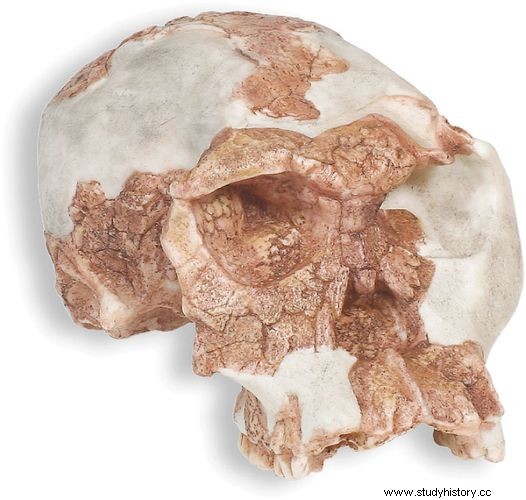In the Olduvai Gorge also spelled Olduvai Olduwai , a paleoanthropological site in the eastern Serengeti plains within the boundaries of the Ngorongoro Conservation Area north Tanzania . It is a steep gorge consisting of two branches that together have a length of 48 km and a depth of 90 meters. Deposits on the sides of the canyon date back approximately 2.1 million to 15,000 years. The deposits have the fossils Remains of more than 60 hominins (members of the human lineage) have been produced and provide the most continuous known record of the human evolution over the last 2 million years and the longest known archaeological record of the development of the stone tool industry. The Olduvai Gorge has been designated as part of a UNESCO World Heritage Site in 1979. Although Olduvai Gorge has often been referred to as "the cradle of mankind," South Africa another World Heritage Site called Cradle of Humanity . Compare Sterkfontein , Swartkrans and Kromdraai .

 Britannica Quiz Destination Africa:Fact or Fiction? Is Africa's northernmost point further north than Europe's southernmost point? See if your geographical knowledge points north or south on this journey through Africa.
Britannica Quiz Destination Africa:Fact or Fiction? Is Africa's northernmost point further north than Europe's southernmost point? See if your geographical knowledge points north or south on this journey through Africa. The Olduvai fossil beds clustered in a lake basin between 7 and 15 km in diameter. The lake is formed by volcanic rocks from the Pliocene (5.3 to 2.6 million years ago) and below from metamorphic deposits from the Precambrian period (more than 542 million years ago) underlaid . Relatively continuous Rift Valley faulting and volcanic action left Olduvai deeply incised. Water flow through the canyon further eroded the rock and laid a demarcated sequence of Layers free, from which evolutionary events could be traced. Seven major stratigraphic units or formations have been distinguished. From oldest to youngest, they are: Bed I (approximately 1.7 million to 2.1 million years old), Bed II (1.15 to 1.7 million years old), Bed III (800,000 to 1.15 million years old), Bed IV (600,000 to 800,000 years old), the Masek beds (400,000 to 600,000 years old), the Ndutu beds (32,000 to 400,000 years old) and the Naisiusiu beds (15,000 to 22,000 years old).

Bed I is at most 60 meters thick. It consists primarily of lava flows, volcanic ash deposits, and deposits. The upper part of the bed (1.7 to 1.85 million years old) contains a rich and diverse fauna and archaeological sites of the Oldowan Industry . It was there in 1959 the English-born archaeologist Mary Leakey discovered a skull fragment of an early hominin that her husband, Louis Leakey , called Zinjanthropus boisei (later reclassified as Paranthropus boisei ). Officially named OH 5 (Olduvai Hominid 5), but dubbed "Nutcracker Man" because of its huge molars (indicating a vegetarian diet), the skull was estimated to be approx Dated 1.75 million years. The discovery showed that hominins evolved in Africa. Instances of Homo habilis , a more human species, was also found at Olduvai. This included OH 24, a skull popularly known as "Twiggy" because it had to be reconstructed from a flattened state.
The remains of Bed I are mostly where streams flow from the volcanic highlands fresh water to the southern edge of an alkaline Sees that existed in Olduvai. Conservation conditions were unusually favorable at these sites, as ash falls from nearby volcanoes and lake surges resulted in rapid burial of the hominin and associated remains. Other finds include Oldowan tools and bones and teeth of various animals, particularly medium-sized antelope. Long animal bones and other bone marrow containing bones have generally been split and fractured and often show cutting marks.

Residences in Beds II, III, and IV are generally in former river or stream canals. Bed II is 20 to 30 meters thick and consists of various rock formations separated by a mismatch or erosive fracture. Only the Oldowan industry occurs below the non-conformity; The so-called developed Oldowan industry and the acheul industry appear at the top. H. habilis Remains were found in the lower third of bed II, and a skull from H. gaster (also called African H. erectus denoted ) was collected near the top of bed II. P. boisei occurs in both the upper and lower parts of bed II.
Beds III and IV were deposited on an alluvial plain. These two units are distinct only in the eastern part of the gorge and are combined elsewhere into a single unit. The two beds have a maximum aggregate thickness of about 98 feet (30 metres) and consist almost entirely of stream-laid detrital sediment. Archaeological sites in Beds III and IV represent the Developed Oldowan and Acheulean industries. Hominin remains there are assigned to H. erectus and other species of Homo .
The Masek Beds accumulated during a period of major faulting and explosive volcanism. They are some 82 feet (25 metres) thick and consist of about equal amounts of stream-laid detrital sediment and aeolian (wind-worked) tuff. Only one archaeological site, of the Acheulean industry, is known in these beds. The Ndutu Beds were deposited during intermittentFaulting, erosion and partial filling of the canyon. Composed largely of Aeolian tuffs, they have a maximum thickness of 24 meters. The Naisiusiu Beds were deposited on the sides and bottom of the canyon after it had been eroded to near its present level. These deposits are up to 10 meters thick and mostly composed of Aeolian tuff. They contain an archaeological site composed of a microlithic tool assembly and a H. sapiens skeleton, both of which are approximately 17,000 years old.


